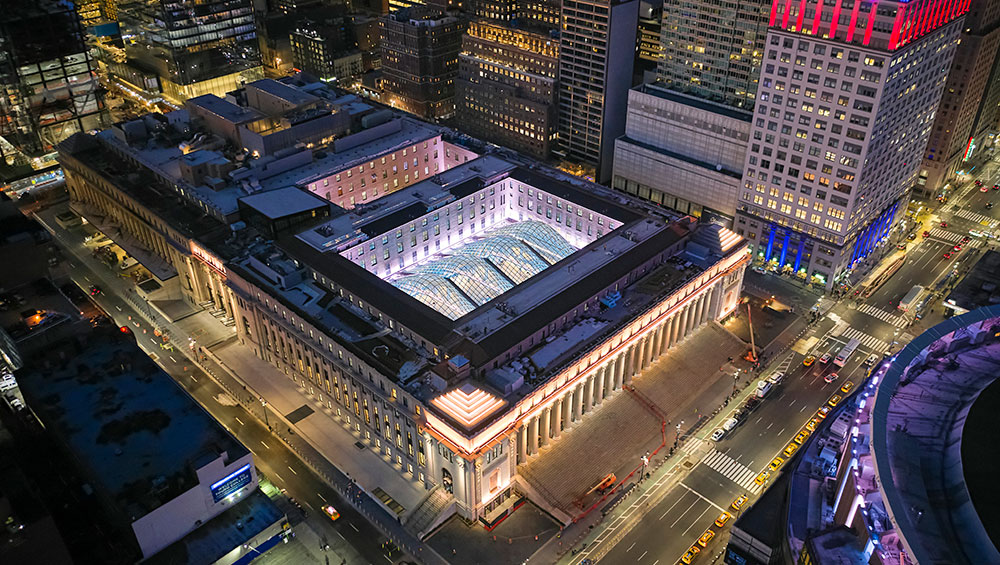
Moynihan Train Hall, Manhattan, 2020. Aerial view. Photo: Lucas Blair Simpson © SOM.
by JILL SPALDING
Irony of ironies, just as the pandemic rethought mass transit, a glorious phoenix has arisen across from the hellish Pennsylvania train station that has too long served the west side of Manhattan as a gateway. To understand the miracle, you have to know the history. In the gilded age of rail and the Vanderbilt/Harriman/Gould fortunes built on it, trains were the kings of transport and their terminus was a palace. To give the Pennsylvania Railroad a royal marker, New York’s purveyors to grandeur, the architectural firm McKim, Mead & White – already commissioned to fashion that other insignia of national sovereignty, the United States Postal Service building – were directed to erect an edifice across from it, with a Roman facade evoking the baths of Caracalla. The labour and materials, together with the lives lost to excavating the tunnels accessing New Jersey and Long Island – all recorded daily in the city’s myriad newspapers – eclipsed even those given for Egypt’s Great Pyramid. With 11 platforms and 21 tracks serving the railroads, a network of intercity trains, and more passengers yearly than the combined population of Europe, Penn station garnered movie star glamour and provided the backdrop – as every movie buff knows – to many a Hollywood film.
.jpg)
Moynihan Train Hall, Manhattan, 2020. Photo: Nicholas Knight, courtesy Empire State Development.
Short triumph: car and jet travel sapped the lifeblood from the mighty streamliners and remaindered Penn Station to the rat-infested doom of neglect. Facing bankruptcy, the owners demolished the majestic building and sold off the air rights to build the Madison Square Garden sports arena, leaving the underground tracks to a gloom embraced only by rats. That the East Side’s Grand Central Terminal escaped the wrecking ball was thanks to the resultant fierce public outcry that produced every Manhattanite’s hero, the Landmarks Preservation Commission.
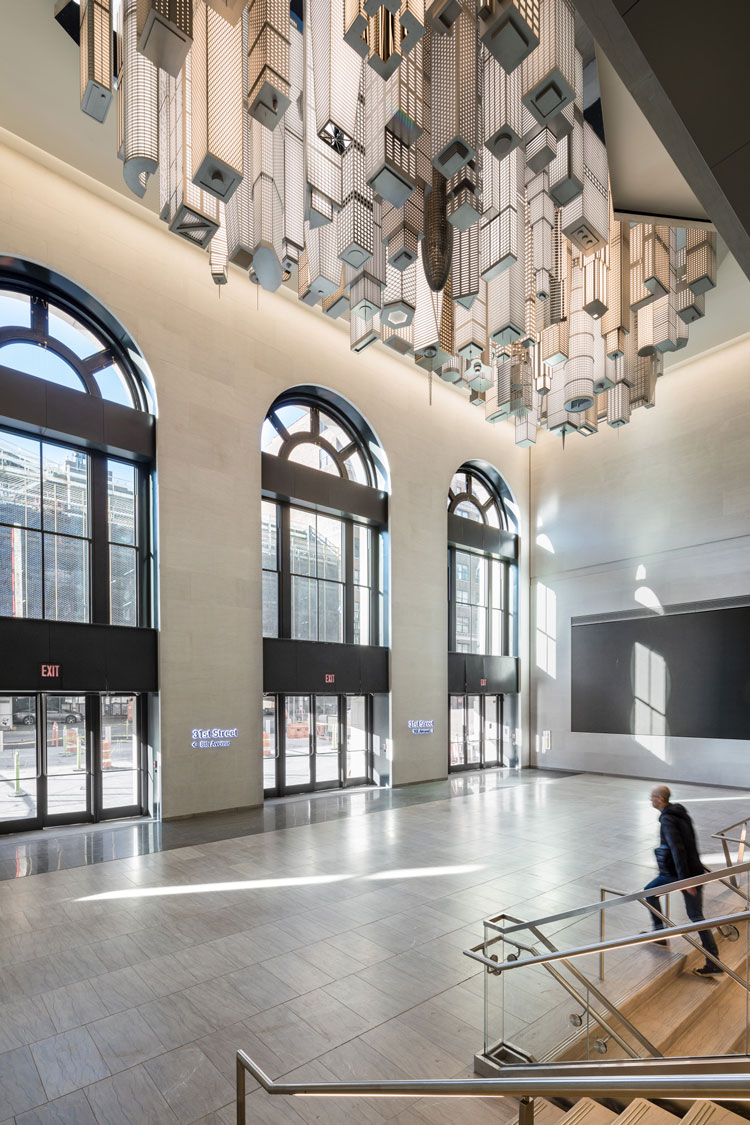
Elmgreen & Dragset, The Hive, 2020. Stainless steel, aluminum, polycarbonate, LED lights, and lacquer. Commissioned by Empire State Development in partnership with Public Art Fund for Moynihan Train Hall. Photo: Nicholas Knight, courtesy Empire State Development and Public Art Fund, NY.
Over the ensuing decades, there were attempts at resurrection, but Congress cut off the funding and Madison Square Garden wasn’t moving, enabling 30 more years of commuter misery. Fast forward to the 1990s when, like a vision in the proverbial desert, it came to Senator Daniel Patrick Moynihan of the eponymous Train Hall that the Beaux Arts post office was sitting over the very same rails. Leaving to the post office the narrow strip it still occupied, the abandoned spaces and the 92ft (28 metre)-high skylight engineered to provide enough light for mail-sorting could be reimagined to serve as – if not a new station, since no tracks would be added – a luminous passageway to Penn’s catacomb and, above ground, an expansive waiting area, a new retail hub and a magnificent gateway.
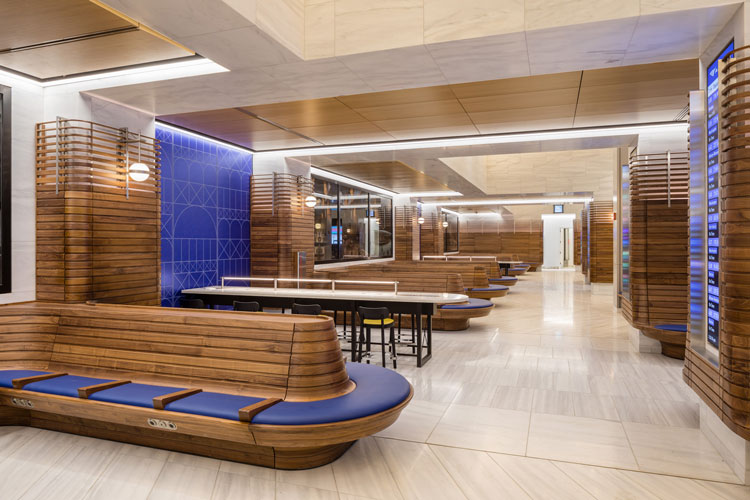
Rockwell Group waiting room, Moynihan Train Hall, Manhattan, 2020. Photo: Nicholas Knight, courtesy Empire State Development.
The concept proposed and the storied architectural firm of Skidmore, Owings & Merrill signed on (at the time headed by all-star, Philip Johnson-heir, David Childs), it was still a long haul – $1.6bn (£1.19bn) to raise and, after the devastation of 9/11, a pre-empting flurry of downtown construction, some urgent (the World Trade Center) some not (Hudson Yards). Miraculously, the money was eventually found and the years of back and forth proposals were resolved. “Can we find a developer?” – yes! the real estate giant Vornado; “a design team?” – yes! the avant garde restaurant designer David Rockwell’s firm; an art coordinator? – but, of course! the city’s beloved Public Art Fund. Finally, to oversee, advise and encourage, the development head Michael Evans (whose premature death is poignantly commemorated on a column) and architecture’s philosopher king, Paul Goldberger.
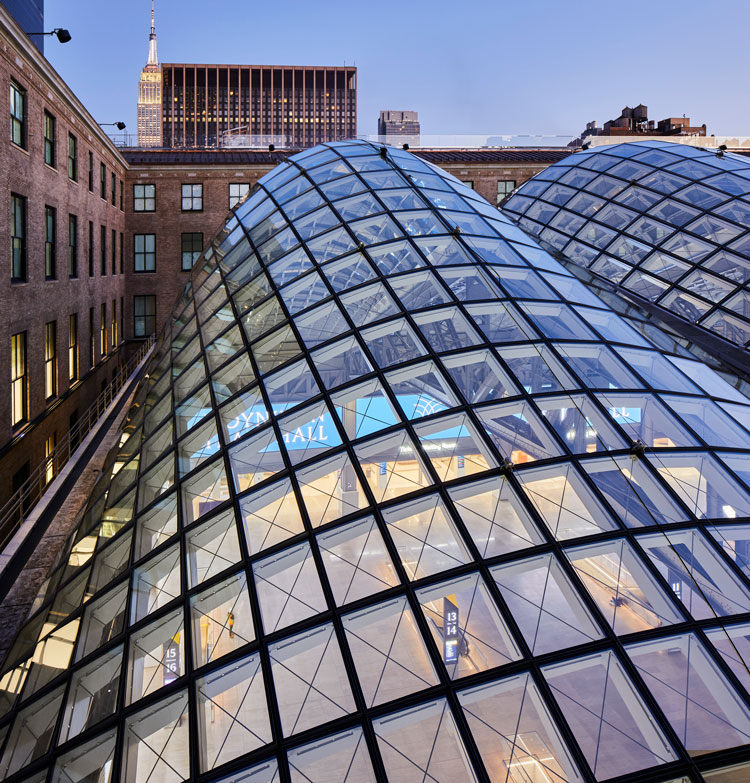
Moynihan Train Hall, Manhattan, 2020. Aerial view. Photo: Lucas Blair Simpson © SOM.
If this sounds like design by a camel, it was, but putting paid to the perils of multiple briefs, what a glory resulted. Together with a clutch of enthusiasts who had walked up to four miles to avoid (the ultimate accolade) four-wheel transport, I visited the first day, forted up against cold and Covid with goggles and mask, and yet the moment I entered I felt unencumbered, so roseate was the lighting, so soft the air, so cheerful the signage, so vaulting the skylights, so transfixing the art.
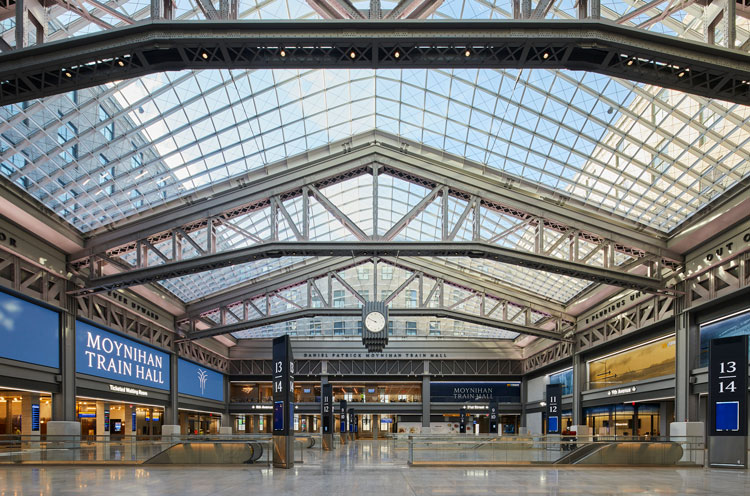
Moynihan Train Hall, Manhattan, 2020. Aerial view. Photo: Lucas Blair Simpson © SOM.
Entering at 31st Street, my first and lingering impression was of an opera set staged now in an ancient city, now in a city of tomorrow, with the va-et-vient of people in a hurry staged against the buzzy backdrop of retail, offices, eateries and amenities that make up the life of city and terminus. Expecting a dominance of steel, marble and glass, I was amazed to discover that the overarching element is light. Heavenly best describes the column-free wash of ambient daylight provided by the new, immense (one acre of glass!), parabolic skylight. Ceilings twinkled by tiny lights form a night sky. The east wall radiates a mesmerising, four-screen, 2,500 sq ft video by The Moment Factory composed of moving panoramas of the Hudson valley as they would be seen from a train; archival and contemporary footage of the city’s trophy buildings, and a behind-the-scenes look at the engineering of the historic post office viewed at the midriff, as when walking the High Line. Like a giant mood ring, dimming and rising with the day’s changing light, a warm, programmable LED system livens the seating and transit areas. Glowing rods edge the balcony railings, shining diode displays post the train schedules, and bold Crayola-coloured signage locates the ticket counter, restrooms, nursing mothers’ lounge and six escalators.
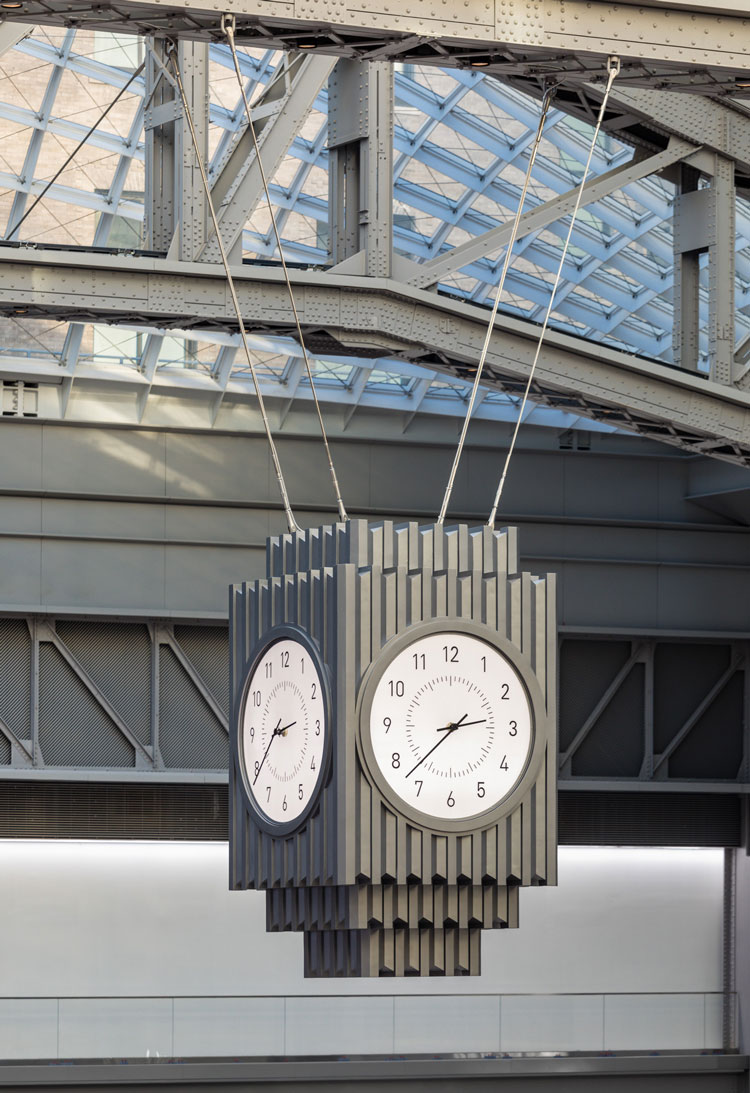
Peter Pennoyer’s steel-framed clock. Photo: Nicholas Knight, courtesy Empire State Development.
Navigating the street level, the eye is drawn to one marvel after another. Look up and, suspended from a truss, hangs Peter Pennoyer’s stunning art deco-inflected clock that speaks to Grand Central Station’s famous “I’ll meet you under the clock” marker. Look across and you glimpse the Rockwell Group-designed waiting room, detailed with warm oak and white-on-blue tiles. Access the second level and find a 730,000 square-foot-wide floorplate of office space, closed off until 2022, but certain to wow as its sole lessee is Facebook.
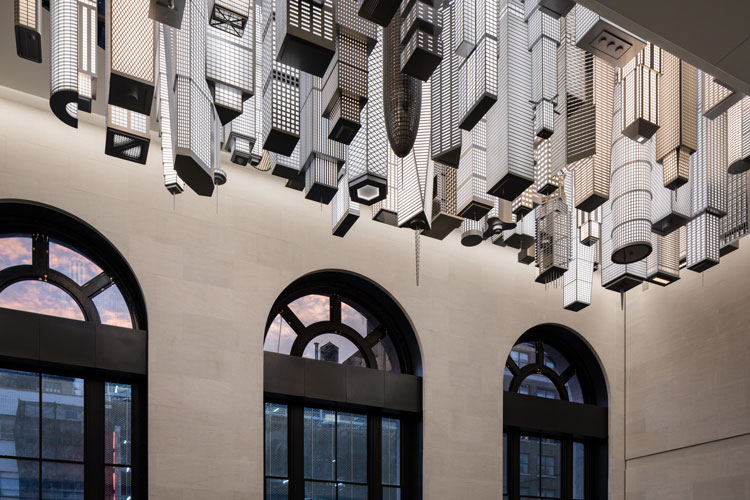
Elmgreen & Dragset, The Hive, 2020. Stainless steel, aluminum, polycarbonate, LED lights, and lacquer. Commissioned by Empire State Development in partnership with Public Art Fund for Moynihan Train Hall. Photo: Nicholas Knight, courtesy Empire State Development and Public Art Fund, NY.
Fortunately, there is no overweening aha feature (Santiago Calatrava still has not lived down the risible motile Oculus imposed on the World Trade Center transit hub). But not to be missed is the art; three works commissioned by the Public Arts Fund to evoke the mobility of transport and energy of New York, past, present and future, that feel as integral to the hall as the trusses.
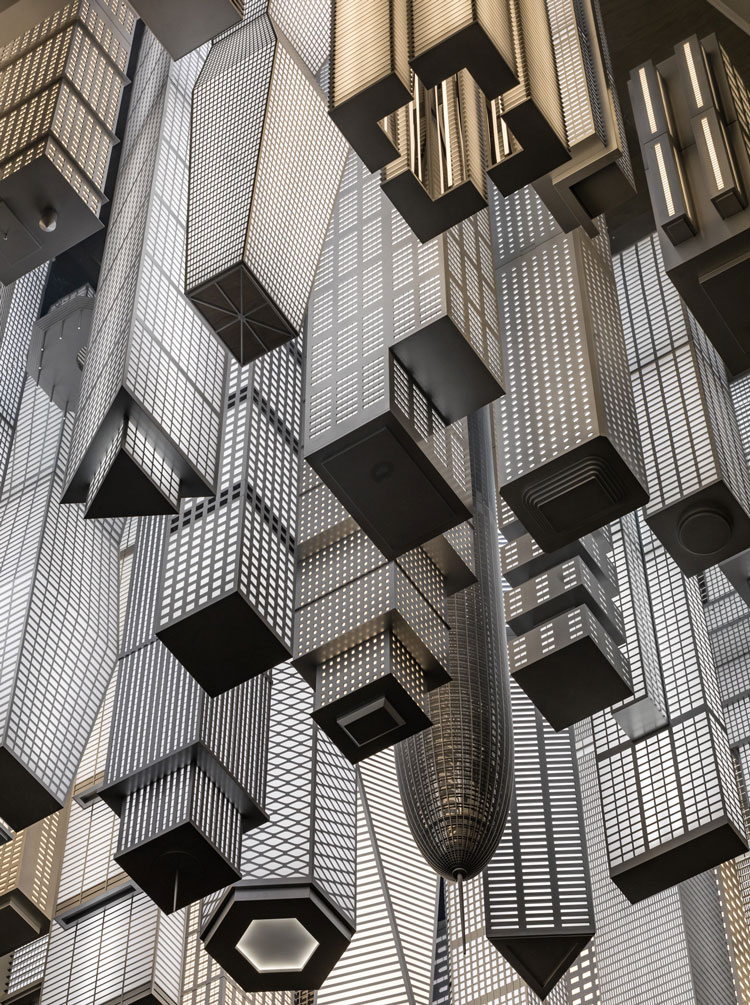
Elmgreen & Dragset, The Hive, 2020. Stainless steel, aluminum, polycarbonate, LED lights, and lacquer. Commissioned by Empire State Development in partnership with Public Art Fund for Moynihan Train Hall. Photo: Nicholas Knight, courtesy Empire State Development and Public Art Fund, NY.
Access by the farthest west 31st Street entrance, look up, and lose yourself in The Hive, a tour de force top-down aluminium and stainless-steel sculpture by artist duo Elmgreen & Dragset of an imaginary yet recognisable skyscraper city – each edifice separately milled and painstakingly finished to convey the magic and majesty of a teeming metropolis.
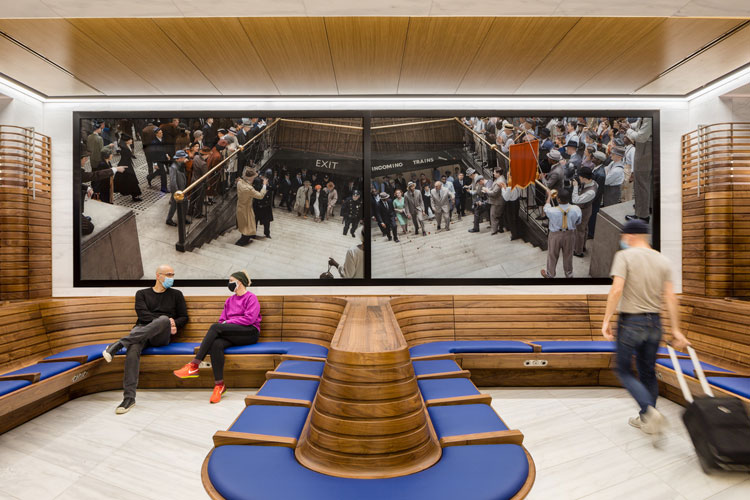
Stan Douglas, 22 April 1924 and 7 August 1934, from Penn Station’s Half Century, 2020. Ceramic ink on glass. One of nine photographic panels from Penn Station’s Half Century. Commissioned by Empire State Development in partnership with Public Art Fund for Moynihan Train Hall. © Stan Douglas. Courtesy of the artist, Victoria Miro and David Zwirner.
Photo: Nicholas Knight, courtesy Empire State Development and Public Art Fund, NY.
To the east, in the ticketed waiting room, find a large-scale photographic work by Stan Douglas, Penn Station’s Half Century, a composite rendition of old New York ceramic-frit-fused into glass – essentially a graphic performance piece realised with individually sourced vintage images that were reinterpreted by costumed actors enacting the comings and goings of everyday life.
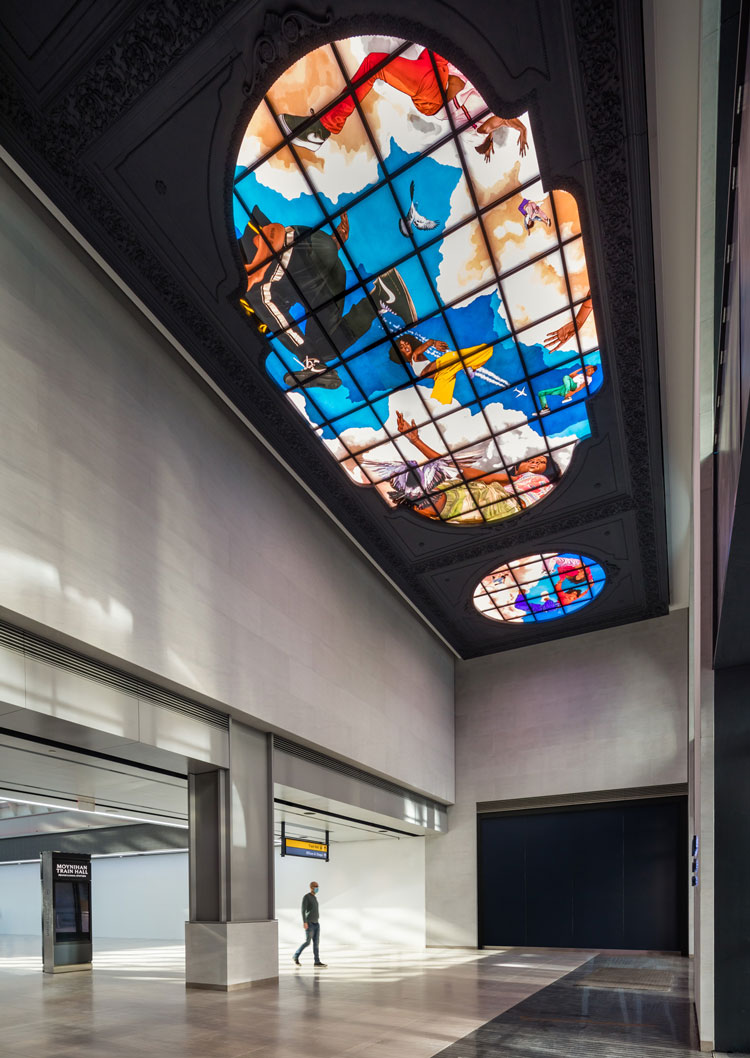
Kehinde Wiley, Go, 2020. © Kehinde Wiley. An original work of art commissioned by Empire State Development in partnership with Public Art Fund for Moynihan Train Hall. Photo: Nicholas Knight. Image courtesy of the Artist, Sean Kelly, New York, Empire State Development and Public Art Fund, NY.
The westernmost 33rd street entrance is irradiated by Kehinde Wiley’s virtuoso, flamboyant, stained-glass ceiling lightbox – a witty riff on crowing Renaissance palace frescoes (a tiny jet and a New York pigeon standing in for the putti) with a Tiepolo/Tintoretto-inflected comment on the city’s irrepressible vibe.
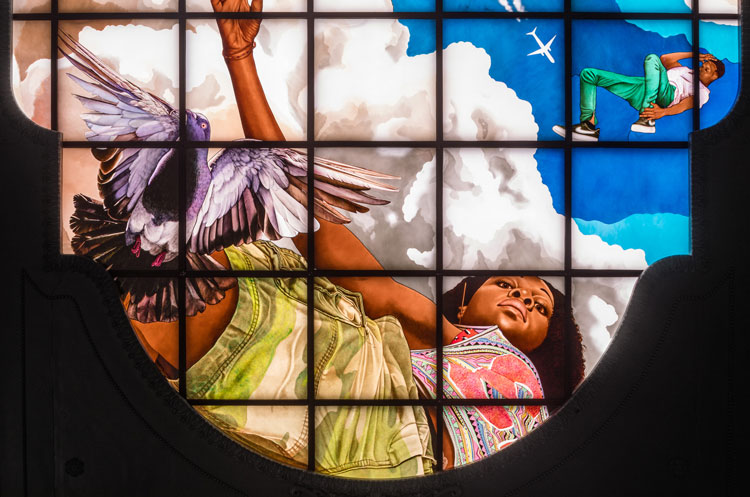
Kehinde Wiley, Go, 2020. © Kehinde Wiley. An original work of art commissioned by Empire State Development in partnership with Public Art Fund for Moynihan Train Hall. Photo: Nicholas Knight. Image courtesy of the Artist, Sean Kelly, New York, Empire State Development and Public Art Fund, NY.
Engaging breakdancing – a New York invention – as the perfect metaphor for the streets’ immigrant and racial energy, Wiley framed his sky-gods’ gravity-defying athletics like a classical painting, referencing the past with a border that reproduces the scrolls and finials on the building’s exterior, and the future with a state-of-the-art, front-and-backlit LED system that glows evenly day into night.
A final walk-through revealed a perfection of detailing – the flawless collusion of design and engineering that only an experenced firm can deliver; seemingly seamless marble flooring sourced from the same century-old quarry as Grand Central, ethereal glass-canopied “courtyards”, elegant support columns, pristine sightlines and an attention to proportion that harks back to the Parthenon.
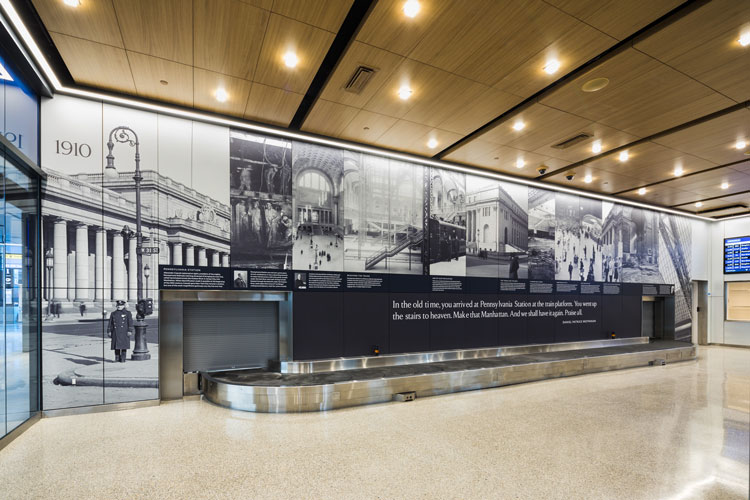
Baggage claim, Penn Station and Farley Building Timeline Mural. Photo: Nicholas Knight, courtesy Empire State Development.
It’s not all good. The grand passageway to the underground rail tracks and subway still leads to a hellhole, exposing the original sin of the demolished Penn station as the neglected stepsister waiting her place in the sun. Alas, as with the Moynihan Train Hall, a meaningful rethink will necessitate not only vision and talent, but serious money. Still, major real estate developers are eyeing post-vaccine cabin fever and, given the number of billionaires sprouting from Manhattan’s skyscrapers, private funding may be eager to name the walls its rail bowels could provide.
There is movement – steps have been undertaken to brighten Penn’s concourses and clean out the grime; but they are, as the saying goes, lipstick on a pig. Unless Madison Square Garden can be tempted to move, a full restoration is not on the cards and, in all fairness, the engineering could be defeating. The Lincoln Tunnel is too close to the station to accommodate a steeper rail climb, so the tracks (and thus, concourses) must remain at a Hades level below those at Grand Central. Nonetheless, where there’s a plan and developer backing, there’s a way, and both are at hand. A scheme proposed by Governor Cuomo for a new interconnecting terminal and rail tracks one block south has been announced as the Empire Station Complex. Name it, design it, fund it, and it will happen.